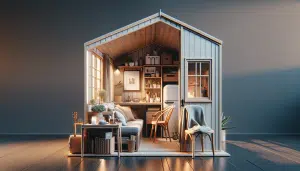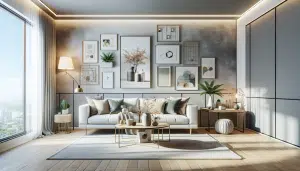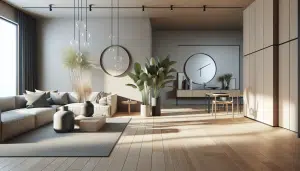Why Minimalism Could Change the Way You Live
Lily Carter October 29, 2025
Minimalism goes beyond just clearing clutter; it can spark a deeper sense of satisfaction and calm in everyday life. Explore how this lifestyle trend can introduce balance, reduce stress, and transform the spaces you use most.
What Draws People to Minimalism
In an age when choices can feel endless, the concept of minimalism has gained widespread appeal. The core idea is simple—adopt fewer possessions and focus more on the essentials that truly add value. People often gravitate towards this lifestyle to combat feelings of overwhelm and constant busyness that stem from having too much. Minimalists claim that paring back possessions can foster an environment where you’re free from excess, making room for new experiences and connections to thrive naturally. As social media brings more eyes to streamlined interiors and “decluttered” living, the interest in minimalism continues to grow for many who are searching for a way to simplify and enrich daily life.
But minimalism is about more than a clean countertop or neatly organized closet. It aims to redefine priorities, helping you intentionally curate your surroundings and routines. The process often starts with reassessing what truly matters—whether it’s relationships, hobbies, or health—and then making choices that align with those values. Gradually, many find that living with less encourages greater contentment, because it’s easier to focus energy on activities and possessions that provide genuine joy. This transition can be liberating, freeing people from cycles of constant consumption and encouraging mindful decision-making instead of reactive spending.
As this lifestyle trend expands, its benefits are being recognized outside of personal spaces. Offices, public areas, and even urban architecture are shifting towards minimalist designs to inspire productivity and foster a sense of clarity. The minimalist movement is also connected to sustainability, as fewer purchases typically result in less waste and a reduced environmental impact. In searching for deeper meaning and less distraction, more people are using minimalism as a blueprint for intentional living, bringing lasting effects to both private and public life.
Minimalism at Home: Transforming Your Space
Minimalism in the home is not just about owning very little. It’s centered around curating the living environment so that every object has a clear purpose or brings delight. For starters, minimalist design often relies on neutral colors, uncluttered surfaces, and multipurpose furniture. Spaces feel more open and calm, which some homeowners find positively affects their mood and focus. Adopting the minimalist lifestyle inside the home can also help simplify household chores, as fewer items often mean less to clean and maintain.
Transitioning towards a minimalist interior can be a gradual process. Many advocates suggest beginning with one area, such as the wardrobe or kitchen, and sorting items to keep only what is essential or truly meaningful. The rest can be donated, recycled, or responsibly discarded. As the process continues, the aim is to embrace quality over quantity—trading stacks of unused gadgets or decorative items for a handful of well-loved, functional pieces. This shift doesn’t mean a home becomes sterile or uninviting; in fact, many minimalist spaces feel more welcoming due to their tranquility and intentional design.
Health and wellness may also benefit from a decluttered living space. Experts say that organized environments can ease anxiety, boost concentration, and even improve sleep quality. When every item in a room serves a clear purpose, it’s easier to create daily routines that support self-care, like meditation or exercise. Minimalist home design isn’t about perfection, but about creating a living area that empowers day-to-day choices and supports an ongoing journey toward greater balance. It’s practical, aesthetic, and deeply personal.
Building Mindful Habits in a Minimalist Life
Developing mindful habits is at the heart of minimalist living. By becoming more intentional about everyday actions—such as what you bring home or how you spend time—new patterns can emerge that foster peace and awareness. Many minimalists journal their daily routines to track patterns and identify sources of stress or joy, which helps inform smarter decisions. This practice can cultivate gratitude for what you have, reducing the urge to accumulate more possessions and reinforcing positive mental health strategies along the way.
Minimalism also invites self-reflection, making it easier to determine which habits or commitments truly align with your desired lifestyle. People often discover a new appreciation for experiences, such as shared meals, time outdoors, or creative hobbies, which may have been overlooked before. Cutting out unnecessary distractions—like digital clutter on devices—creates space for more meaningful activity. While minimalism itself isn’t a cure-all, those who practice it find that mindful living brings a sense of liberation, increased focus, and better emotional balance.
One common misconception is that minimalism restricts enjoyment. In reality, it’s about maximizing fulfillment and giving yourself the mental bandwidth to pursue what you love. Whether it’s reading, art, or connecting with friends, these habits are supported—and even made easier—by a minimalist lifestyle. As the minimalist trend continues to inspire wellness and self-awareness, more people are integrating mindfulness practices into daily living, reshaping their approach to productivity and happiness.
Minimalism and Sustainability: A Natural Partnership
Sustainability and minimalism go hand in hand. By reducing excess consumption, individuals naturally lower their environmental footprint. Many minimalists aim to cut down on waste, especially single-use plastics and fast fashion, which are significant contributors to pollution worldwide. Choosing multi-purpose products, high-quality clothing, and locally-sourced goods further supports a less resource-intensive lifestyle. This conscious consumption can create ripple effects, influencing friends, family, and even businesses to reconsider their environmental impact.
The intersection of minimalism and sustainable living has also prompted new solutions in home design, transport, and energy use. Architects and designers are increasingly opting for materials with minimal environmental impact, while urban planners look to create public spaces that are both functional and sustainable. Simple changes—like repairing instead of replacing, or borrowing instead of buying—help individuals contribute to the health of the planet. These steps may seem small, but when multiplied across communities, they can result in significant environmental benefits over time.
Educational programs and organizations now provide guidance for those who want to combine minimalism with eco-friendly habits. For example, resources exist for learning how to recycle correctly, reduce household energy use, and compost food scraps. Small shifts toward living with intention support collective sustainability goals and can even save money in the long run. Ultimately, the minimalist mindset nurtures stewardship of resources, demonstrating that purposeful choices support both individual well-being and environmental resilience.
Entertainment and Joy: Rethinking How We Have Fun
For many, entertainment often involves acquiring tickets, gadgets, or new experiences—sometimes at the cost of accumulating clutter. The minimalist lifestyle encourages a different approach, placing greater emphasis on activities that prioritize relationships and personal growth. This might mean opting for a home-cooked dinner with friends over a flashy outing, or sharing books and music instead of buying new items. These experiences often provide deeper satisfaction and can foster lasting connections.
Activities like walking in nature, creative art sessions, community sports, or family board games all align with minimalist entertainment. These experiences don’t require excess spending or physical treasures but offer enrichment through engagement, challenge, and togetherness. Social gatherings become more about meaningful interaction than material consumption. For many, this approach creates a sense of abundance and gratitude for simple pleasures, making entertainment feel more vivid and significant.
Minimalist entertainment may also inspire people to explore hobbies that don’t depend on screens, gadgets, or costly purchases. For example, learning a musical instrument, joining a book club, or volunteering locally can generate lasting fulfillment. By focusing on what brings genuine enjoyment and reducing the impulse to acquire more, minimalists unlock new ways to stay entertained, build community, and develop a lifestyle that is as joyful as it is intentional.
Common Challenges and Simple Solutions in Minimalist Living
While the minimalist lifestyle brings many benefits, it’s not uncommon to encounter challenges along the way. Emotional attachment to possessions is one of the biggest hurdles, as sentimental or gifted items can be difficult to part with. Some people worry about feeling deprived or missing out on fun if they cut back too much. The solution? Start small—set aside an hour a week to tackle a specific drawer or shelf. Gradual change allows time for adjustment and helps prevent regret or second-guessing decisions.
Communication plays a key role, especially when living with others who may have different comfort levels with decluttering. It’s important to listen and compromise, encouraging a shared vision rather than enforcing strict rules. Some families adopt a minimalist ethos only in shared spaces, while others find creative ways to blend personal styles. Regular check-ins help ensure everyone feels comfortable, and household harmony remains a priority.
Staying motivated can be a challenge when external influences—like advertising or social media—encourage accumulation. To combat this, setting clear intentions and reflecting regularly on the reasons for pursuing minimalism can be very helpful. Visual reminders, such as photos of peaceful spaces or written values statements, can reinforce your goals. With patience and flexibility, most find that the benefits outweigh initial obstacles and that living minimally is ultimately a rewarding, sustainable choice.
References
1. Becker, J. (n.d.). What is Minimalism? Retrieved from https://www.becomingminimalist.com/what-is-minimalism/
2. National Institute of Mental Health. (n.d.). Coping with Stress. Retrieved from https://www.nimh.nih.gov/health/topics/coping-with-stress
3. Environmental Protection Agency. (n.d.). Sustainable Management of Materials. Retrieved from https://www.epa.gov/smm
4. American Psychological Association. (n.d.). How clutter affects your brain (and what you can do about it). Retrieved from https://www.apa.org/topics/brain-health/clutter
5. The Minimalists. (n.d.). 16 Rules for Living with Less. Retrieved from https://www.theminimalists.com/16rules/
6. New York Times. (n.d.). How Minimalism Brought Me Closer to Happiness. Retrieved from https://www.nytimes.com/guides/smarterliving/how-to-pack-for-moving







